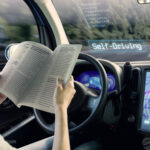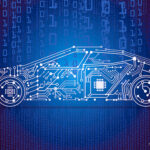Defining the concept
V2H or vehicle-to-home is when a bidirectional EV charger is used to supply power (electricity) from an EV car’s battery to a house or, possibly, another kind of building. This is done via a DC-to-AC converter system usually embedded within the EV charger. It is similar to V2G (Vehicle-to-Grid), but the energy is used locally to power a home instead of being fed into the electricity grid. This enables the EV to function like a regular household battery system to help increase self-sufficiency, especially when combined with rooftop solar. It allows for two-way power flows between your home and your electric vehicle (EV). This means as well as charging your EV as normal, you can use the energy stored in your EV battery to power your home when it makes sense to do so.
Another benefit of V2H is the ability to provide backup power in the event of a blackout. V2H can help save money on your energy bill and reduce carbon emissions. Using your EV’s battery to power your home at peak times allows you to avoid paying high energy prices from the grid, at times when the grid uses the most fossil fuels. The V2H charger will dynamically adjust its power output to match your home’s power needs. You can charge your EV later during off-peak hours when electricity is greener and cheaper.
Adoption of the concept and current practices
Using V2H (vehicle-to-home) concept means that EV owners can utilise their electric cars as a power source for the household to save money on electricity bills, or as backup power during blackouts or emergencies and support the adoption of renewable energy. From the position of having to charge your EV with electricity taken from the grid, you’ll naturally have to pay for it, but the cost will be significantly cheaper when compared to what you’d fork out to fill your tank up with petrol or diesel. And so people are highly interested in it. There are around 20 moving parts in the motor of an EV, compared to about 2000 in an ICE vehicle. With no need for engine oil, pistons, or even complex transmissions (most EVs use only one gear). EVs require very little in the way of regular servicing, saving you even more money.
Only a few EVs currently feature V2H technology, including the later model Nissan Leaf and Mitsubishi Outlander PHEV, which both use the older-style CHAdeMO connector. The new Ford F-150 Lightning EV is unique in a sense that it is the first vehicle with bidirectional charging capability to use a CCS connector. However, it can only function when used with the ford charge station pro along with the Ford Home Integration System. The F-150 Lightning also features Vehicle-to-load (V2L) technology as well.
V2H reduces CO2 emissions by supplying energy from your EV to your home at peak times. In the UK, 27% of GHG emissions come from transport, of which road transport accounts for over 90%. Electrification is recognized as the most effective way to decarbonize the transportation sector globally. China will aim to stop contributing to climate change and go carbon neutral by 2060 and in the USA, California banned the sale of cars based on fossil fuels by 2035. In China, more than 1.2 million EVs were sold in 2018, a 63% increase over 2017 sales, and in the USA, more than 360 thousand EVs were sold in 2018, an 81% increase over 2017 sales. In India, EV sales are predicted to reach 30% for private cars, 70% for commercial cars, and 40% for buses by 2030. So, it is quite clear that the whole world is now concerned about the health of the environment and adapting or practicing V2H in a day to day life is now obligatory.
Major players globally
Among the few EVs currently featuring V2H technology, the Nissan Leaf and Mitsubishi Outlander PHEV are the famous ones. Kia EV6 is also trying to add up to the team. Companies like Indra, delta, and Hager group provide installment of the charger and all the V2H services.
The Nissan Leaf is the world’s first 100-percent electric, zero-emission car designed for the mass market. Nissan is working with partners like EGAT to bring inexpensive equipment to the market to popularize V2H. Since they introduced V2H in 2012 in Japan, according to the research, the total V2H sales number has exceeded 8,300 units (V2H devices) in Japan (as of march 2020). Nissan LEAF can generate electricity consumption of approximately 12 kWh/day. In Typhoon Roke in Japan in 2011 Nissan leaf helped thousands of people as a powerful support vehicle when the whole nation was blacked out.
Mitsubishi Motors has been developing electric vehicles (EVs) from early on to tackle environmental problems such as global warming and air pollution. Through a V2H device, the drive battery of their PHEV can supply up to 12 days of power to a general household if fully charged and fueled when combined with power generation in the engine. PHEV gives you the freedom to roam as you like, with plenty of options to power up and go including charging stations, DC fast charging, and even regular 120v power outlets. It can be charged within 25 minutes by using a DC charger. It became the winner of the Motors Trend 2021 recognized as having overall lower than average maintenance cost.
Ford is the first in the U.S. to offer the ability for customers to power their homes with an electric truck when the grid goes dark, providing innovative new capabilities that enhance the energy independence of its customers. F-150 Lightning with available Ford Intelligent Backup Power can provide power and security during an electrical outage. It is the first electric truck in the U.S. to offer this capability. In the future, new features will be offered as additional ways to manage energy use and potentially save on energy costs.
PG&E and Ford Motor Company announced a collaboration exploring how Ford’s new F-150 Lightning electric vehicle (EV), the first commercially available light-duty truck with bidirectional charging technology can interact with the electric grid and provide electric reliability benefits to PG&E customers. PG&E and Ford will test the F-150 Lightning and its Intelligent Backup Power bidirectional charging capabilities in providing backup power for customers’ homes in PG&E’s service area. Intelligent Backup Power, making its debut on F-150 Lightning, gives customers the ability to use bidirectional power technology from their all-electric truck to provide up to 10 days of power to their homes during an outage, depending on home energy usage.
Kia EV6 is the first BEV( Battery electric vehicle) built by Kia. They have dedicated this EV platform guaranteeing your drive will be 100% Co2 free. The EV6’s advanced battery charges 10 to 80 percent in just 18 minutes. A man from Canada reported that when everyone was suffering through the electricity crisis caused by the hurricane named Fiona, he was able to use his KIA EV96 to power his house for over a week after the storm tracked right through the small province. Powered by a 77.4kWh battery, the EV6 can output a maximum of 3.6kW via its vehicle-to-load (V2L) function. This affords the Kia to deliver power at maximum output for a total of 21.5 hours.
Major players in the Middle East
Other than Nissan, Mitsubishi and KIA, Audi is entering the V2H market very soon.
Audi will be launching a vehicle-to-home (V2H) network throughout the Middle East. This will enable EVs to send energy toward the house or the wider network where they’re plugged in. It could provide a boost to EVs in a region that lags behind others in terms of electrification. Audi is launching the network together with another German company: Hager Group, a specialist in electrical installations.
Electric vehicle owners in Dubai and across the United Arab Emirates have been enjoying few privileges compared to commuters using ICE vehicles such as free parking, reduced registration fees, and others. According to some forecasts, EVs could make up 15% of all vehicles in the region by 2025 in the Middle East. This will require a massive uptick in charging stations, both publicly accessible and home-based. But people prefer home charging as it allows users to make maximum use of lower electricity tariffs, often charged overnight.
This form of energy self-sufficiency is becoming an increasingly important issue during the energy transition. More and more homeowners are now becoming prosumers of self-generated electricity and adding up to the team of vehicle-to-home (V2H) technology.






